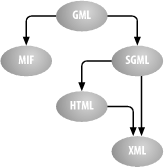Chapter 21. XML
Introduction
The Extensible Markup Language, or XML, is a portable, human-readable format for exchanging text or data between programs. XML is derived from the parent standard SGML, as is the HTML language used on web pages worldwide. XML, then, is HTML’s younger but more capable sibling. And since most developers know at least a bit of HTML, parts of this discussion compare XML with HTML. XML’s lesser-known grandparent is IBM’s GML (General Markup Language), and one of its cousins is Adobe FrameMaker’s Maker Interchange Format (MIF). Figure 21-1 depicts the family tree.

Figure 21-1. XML’s ancestry
One way of thinking about XML is that it’s HTML cleaned up, consolidated, and with the ability for you to define your own tags. It’s HTML with tags that can and should identify the informational content as opposed to the formatting. Another way of perceiving XML is as a general interchange format for such things as business-to-business communications over the Internet or as a human-editable[1] description of things as diverse as word-processing files and Java documents. XML is all these things, depending on where you’re coming from as a developer and where you want to go today—and tomorrow.
Because of the wide acceptance of XML, it is used as the basis for many other formats, including the Open Office (http://www.openoffice.org) save file format, the SVG graphics file ...
Get Java Cookbook, 2nd Edition now with the O’Reilly learning platform.
O’Reilly members experience books, live events, courses curated by job role, and more from O’Reilly and nearly 200 top publishers.

